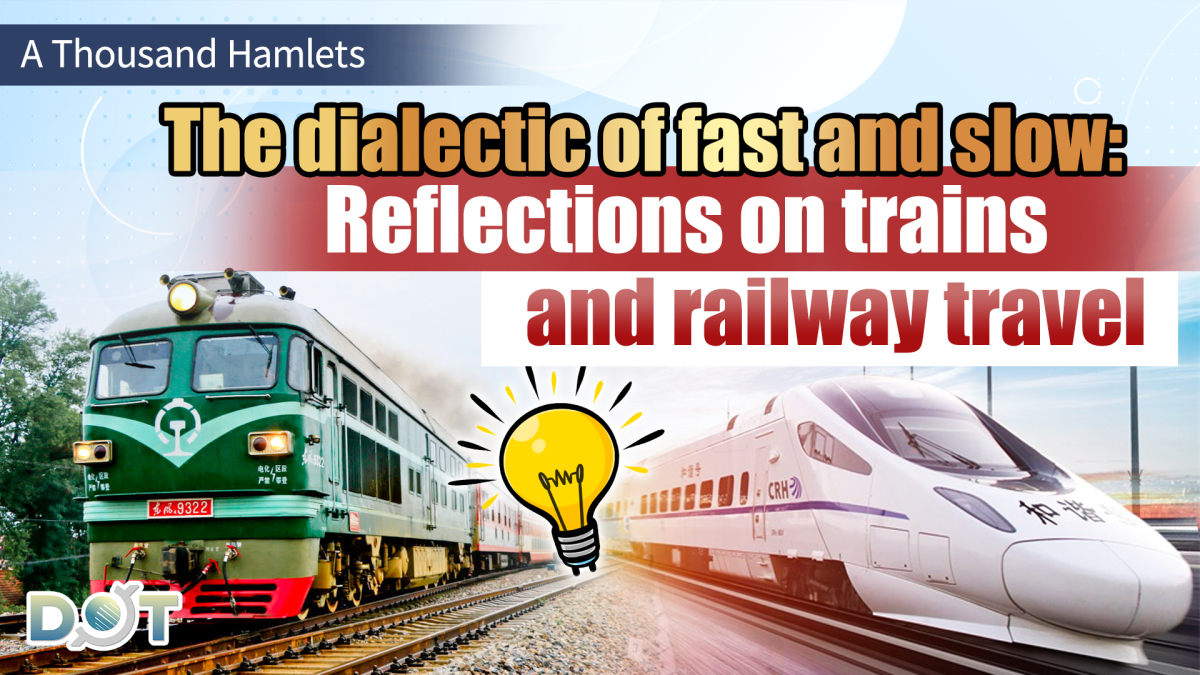
By Xu Xi
Did you travel during the past National Day holiday? Did you take the high-speed train? In recent years, Guizhou has attracted many Hong Kong people seeking a cool retreat because of its pleasantly cool weather and magnificent scenery. During last summer vacation, I met an old friend from Hong Kong in Guiyang. While chatting, I learned in surprise that there are now three daily high-speed trains from Hong Kong directly to Guiyang. Departing from West Kowloon, the fastest train takes only 4 hours and 53 minutes to reach Guiyang East—almost an hour faster than traveling from Zhuhai!
I couldn't help recalling the summer of 1999, when I took the train to Guangdong for the first time. Back then, the journey involved taking the Xiang-Qian Railway through Hunan, entering Northern Guangdong via Pingshi, and it took almost a full day and night to arrive at Guangzhou Railway Station. If one wanted to continue to Hong Kong, they had to transfer at Guangzhou East Station and take the through-train on the Kowloon–Canton Railway, which took another two hours to reach Hung Hom. People used to say "departing in the morning and arriving in the evening" to describe convenient travel, but now, traveling from Hong Kong to Guiyang is truly "departing in the morning and arriving by noon." The speed of the high-speed rail is indeed astonishing!
"Sitting on Speed": The Modern Sensory Experience
Since the late 19th century, when trains and railways first entered China, they brought Chinese people a new experience of time and space—most notably, the sensation of rapid mobility. Dianshizhai Pictorial (點石齋畫報), a popular illustrated newspaper in the late Qing dynasty, recorded Chinese reactions to Western technology through its illustrated reports of "newsworthy and remarkable events." Scholar Li Siyi has keenly observed that many of its images depict trains and railways, but rarely do we see a train standing still at a station; almost all are in motion, with thick smoke billowing from their chimneys. Many other periodicals at the time also focused on the dangers brought by the speed of trains, such as collisions with elephants, derailments, or trains hitting pedestrians.
Velocity was the train's greatest sensory shock, and the modern media and literature of the time reinforced this impression. The New Sensationist writer Liu Na'ou, known for his precise rendering of urban modernity, opened his 1930 short story Scenery (風景), which is set on a train journey, with these lines: "People are sitting on speed. The fields fly past. The little rivers fly past. The cottages, stone bridges, and willows—all the scenery only occupies a moment in the retina before disappearing."
The poet Xu Zhimo, a passionate traveler, expressed a similar feeling in his 1923 poem Along the Shanghai–Hangzhou Route (滬杭道中):
Hurry, hurry, hurry! Rush, rush, rush!
A wisp of smoke, a stretch of hills, a few shadows of clouds,
A strip of water, a little bridge, a sound of oars,
A grove of pines, a clump of bamboo, red leaves falling—
Bright fields, bright autumn scenes,
Clear as dreams, then blurred, then gone—
Rush, rush, rush! Are those wheels or time itself?
Rushing the autumn away! Rushing life away!
匆匆匆! 催催催!
一捲煙,一片山,幾點雲影,
一道水,一條橋,一支櫓聲,
一林松,一叢竹,紅葉紛紛:
艷色的田野,艷色的秋景,
夢境似的分明,模糊,消隱——
催催催! 是車輪還是光陰?
催老了秋容! 催老了人生!
Both writers use short, repetitive phrases to convey the rhythm of high speed. Xu Zhimo even uses onomatopoeia (匆匆匆,催催催) to mimic the sound of old trains clattering over tracks. In their depictions, the train's velocity evokes not only joy and excitement but also tension and unease. In the rapidly changing modern world, traditional landscapes—cottages, bridges, drifting clouds—are no longer stable or enduring. Life grows busier; the pace of the age accelerates; people lose the leisure to wander through the countryside. Classical scenery becomes blurred and fleeting.
"Heading Toward an Infinite Future": The Train as Metaphor
While the romantic Xu Zhimo lamented the fleeting nature of time and life on the Shanghai–Hangzhou train, Sun Lianggong's Forward (前途), also set on the same route, conveys a different attitude. The story depicts an anonymous traveler's observations and conversations on a train. On the surface, the passengers discuss travel, but their dialogue often turns into philosophical reflections on fate and life. For example, one woman says, "It's so crowded—should we go or not?" The man replies, "The ticket? That's not the issue. Go or not go—it's up to us. A ticket can't limit our will! Even if fate has been determined, we can still defy it. It's no good to keep hesitating like this!"
The conversation leaps from buying a ticket to defying fate—something more like dramatic stage dialogue than casual, everyday speech. Clearly, the author uses train travel as an allegory for life itself. This intention becomes explicit at the story's end:
In this long journey, our lives are all entrusted to this narrow train. The scenery outside surges past—within a fraction of a second, it's gone into the past... Though everyone's future joys and sorrows, dangers and safeties, remain in the 'unknown account book,' none of them seems to have the slightest attachment to the past.
Now the train, full of machines, is heading toward an infinite future! The land outside the windows spins like a flight. The passengers sit in silence, chat and laugh loudly, or hum tuneless songs—each waiting for the future they expect.
Sun Lianggong (born 1894 in Longhui, Hunan) entered Beijing Higher Normal School in 1916 and was an active figure in student literary circles. He participated in the May Fourth Movement—a typical May Fourth youth. As Professor Chen Jianhua points out in Literature Conveying the Train (文以載車:民國火車小傳), the "train" here symbolizes society and the era, while "travel" represents a historical journey toward a new direction. "The past," then, refers not only to scenery but also to memory and history. After the May Fourth and New Culture movements, young people bid farewell to the past, determined to take destiny into their own hands, and warmly embraced a new future with optimism and faith. Though this story might read somewhat abstractly, it was included in The Complete Works of Modern Chinese Literature (中國新文學大系,1935) precisely because it so powerfully embodied the Zeitgeist of the May Fourth era.
The Dialectic of Fast and Slow: Nostalgia for the Green Trains
The poet Mu Xin once wrote a short piece about travel called In the Past, Life Was Slow (從前慢), and sometimes read like:
I remember my youth...
Early morning at the train station,
The long street dark and empty,
A small shop selling hot soy milk steaming in the cold air.
Time used to move slowly—
Carts, horses, mail all moved slowly.
A lifetime was only enough to love one person.
Through contrasts between past and present, warmth and cold, slow and fast, the poet evokes a deeply nostalgic mood. In our fast-paced, ever-changing age—crushed by work, driven by desires—many urbanites find themselves struck by Mu Xin's words, longing for the calm of slowly sipping a hot soy milk, patiently waiting for a letter, and quietly sharing a life with one beloved person.
In recent years, this longing has sparked a trend of nostalgic "green-train journeys." Yet as the high-speed rail network expands, few of these old-style slow trains remain. For those who lack time to experience them firsthand but still wish to revisit the railway travel of decades past, a few books may satisfy that yearning.
Folk singer Zhou Yunpeng's essay collection Green Train (綠皮火車) records his poetic life of wandering, singing, and making friends to the rhythm of the "reggae beat" of train wheels. In Chinese People on the Train (火車上的中國人), photographer Wang Fuchun captures the human drama of 1990s green train travel: steaming instant noodles, bulging plastic woven bags, families sprawled in the aisle between cars. Looking at those black-and-white photos, one is instantly transported back to a crowded train of "chunyun" 春運 in the 1990s, hearing peddlers' melodious cry, "Cigarettes-beer-mineral water; peanuts-sunflower seeds-poker cards!" (香煙啤酒礦泉水,瓜子花生撲克牌!)
Traveler and photographer Qi Dong's Green Train: To the Countryside China (綠皮火車,去鄉野中國) takes readers to northeastern forests, small southwestern towns, and old Third Front industrial sites—places once bustling because of the railways, now fallen silent in the high-speed era. Between liveliness and quietude lies the history of China's railways and the emotional journeys of its passengers over the decades.
When traveling for business, we hope the high-speed train is as fast as possible. But when traveling for pleasure, we wish it would slow down, giving us time to savor the scenery and local flavors along the way. Modern people live in the dialectic between fast and slow—anxious yet joyful.
Xu Xi is a literary scholar teaching at BNBU, Zhuhai. Xu holds a PhD from HKU.
The views do not necessarily reflect those of DotDotNews.
Related Readings:
A Thousand Hamlets | Slow it down: Walking together into László's labyrinthine sentences




















Comment